Spring is here, and it’s an exciting time! Our bird friends in the San Bernardino mountains begin to sing, and these year-round populations are complemented by a whole new host of migrants. To many people, so many new birds and songs present a daunting challenge. How in the world do we identify all of them?! Worry not; in this post I will provide a quick glimpse of some frequently seen and heard spring birds of the San Bernardino mountains. Taking the time to learn these birds’ colors and sounds can add a new dimension to our students’ experiences and enrich our own lives immeasurably.
Western Tanager (Piranga ludoviciana)
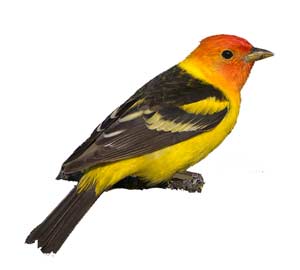 ID Tip: A bright red head and yellow body make this common summer resident impossible to miss. Females lack the red head and display a less vivid yellow.
ID Tip: A bright red head and yellow body make this common summer resident impossible to miss. Females lack the red head and display a less vivid yellow.
Fun Fact: The red coloration of this tanager’s head comes from a compound called rhodoxanthin. The bird cannot synthesize this compound; it is derived entirely from the diet!
Song: A continuous series of hoarse phrases.
White-breasted Nuthatch (Sitta carolinensis)
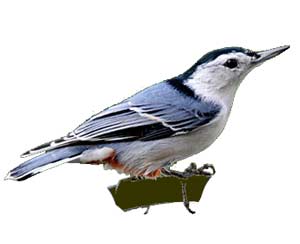 ID Tip: Identify the White-breasted Nuthatch by its black cap, its all-white face, and its behavior of crawling headfirst down tree trunks.
ID Tip: Identify the White-breasted Nuthatch by its black cap, its all-white face, and its behavior of crawling headfirst down tree trunks.
Fun Fact: Nuthatches are named for their habit of wedging a hard food item such as a nut into a bark crevice and hammering or hacking (“hatching”) it with the bill to open it.
Song: A persistent, nasal yank yank yank.
Western Bluebird (Sialia mexicana)
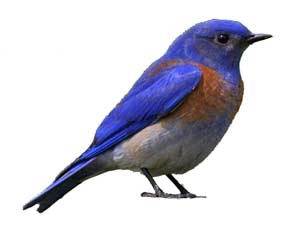 ID Tip: Look for a blue bird with a reddish breast. Females are similarly colored but duller.
ID Tip: Look for a blue bird with a reddish breast. Females are similarly colored but duller.
Fun Fact: Bluebirds nest in cavities, but they’re not built like woodpeckers. They can’t excavate their own holes, so they rely on other birds or natural processes to make the holes for them. Thus, dead trees are a valuable resource.
Song: A quiet, pointed few repeated in quick succession.
Pygmy Nuthatch (Sitta pygmaea)
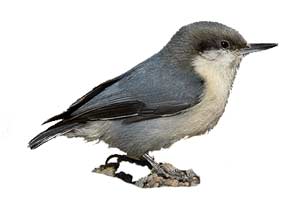 ID Tip: These little guys are more often seen than heard. Look for flocks of tiny, excited birds.
ID Tip: These little guys are more often seen than heard. Look for flocks of tiny, excited birds.
Fun Fact: Pygmy Nuthatches weigh about a third of an ounce and eat about nine calories per day. They huddle together and use controlled hypothermia to survive cold nights.
Song: High-pitched, incessant peep-peep.
Western Wood-Pewee (Contopus sordidulus)
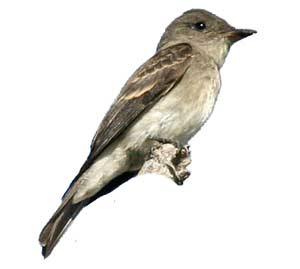 ID Tip: A late spring arrival, this drab, gray flycatcher is best identified by voice. Look for flycatching behavior in this species as well.
ID Tip: A late spring arrival, this drab, gray flycatcher is best identified by voice. Look for flycatching behavior in this species as well.
Fun Fact: This species and the Eastern Wood-Pewee used to be considered a single species; in fact, they have a very different song and don’t appear to interbreed at all where their ranges overlap.
Song: An upward or downward slurred pee-yee.
Brown Creeper (Certhia americana)
 ID Tip: Listen for a quick, tinny series of notes, then look for the tiny, camouflaged creeper crawling alone up a tree trunk. Remember: creepers climb up, nuthatches most often climb down.
ID Tip: Listen for a quick, tinny series of notes, then look for the tiny, camouflaged creeper crawling alone up a tree trunk. Remember: creepers climb up, nuthatches most often climb down.
Fun Fact: Creepers burn an estimated 4-10 calories per day. By eating a single spider, a creeper gains enough energy to climb nearly 200 feet vertically!
Song: A thin, liquidy series of notes; can be verbalized as trees, trees, trees, see the trees.
Northern Flicker (Colaptes auratus)
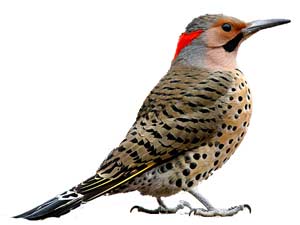 ID Tip: This species, the only brown woodpecker in our area, has reddish wings and a conspicuous white rump patch as it flies away.
ID Tip: This species, the only brown woodpecker in our area, has reddish wings and a conspicuous white rump patch as it flies away.
Fun Fact: There are two subspecies of the Northern Flicker: the Red-shafted Flicker in the western United States and the Yellow-shafted Flicker in the east. If you find a feather with a red main shaft, it’s probably from one of our Northern Flickers.
Song: An emphatic, downward slurring klee-yer, song is a loud kik-kik-kik-kik-kik.
Anna’s Hummingbird (Calypte anna)
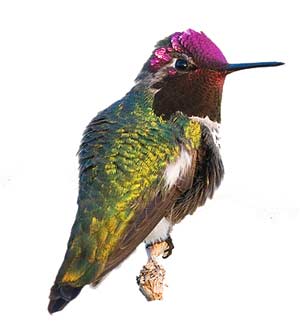 ID Tip: If you see a hummingbird in the San Bernardino Mountains, it’s probably an Anna’s Hummingbird. The iridescent pink head can appear to be black when it’s not catching the sun just right.
ID Tip: If you see a hummingbird in the San Bernardino Mountains, it’s probably an Anna’s Hummingbird. The iridescent pink head can appear to be black when it’s not catching the sun just right.
Fun Fact: Anna’s Hummingbirds normally have a body temperature of around 107 degrees Fahrenheit. When outside temperatures fall, Anna’s and many other species of hummingbirds enter torpor. Their breathing and heart rate slow, and their body temperature can fall as low as 48 degrees Fahrenheit.
Song: Squeaking, grating notes.
Band-tailed Pigeon (Patagiones fasciata)
 ID Tip: The only common wild pigeon in our forest. Look for flocks flying quickly overhead with powerful flaps of their wings.
ID Tip: The only common wild pigeon in our forest. Look for flocks flying quickly overhead with powerful flaps of their wings.
Fun Fact: Pigeons and doves are the only North American birds capable of drinking without raising their heads (other birds must dip the bill into water and raise it to let the water run into the throat). Related to this ability is the fact that pigeons and doves have an unusual need for water, drinking up to 15 percent of their body weight each day.
Song: A soft, owl-like HU-whoo. Listen closely!
You probably already know the following birds, some of the most common in our forest. But do you know their songs?
Mountain Chickadee (Poecile gambeli)
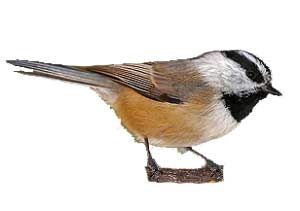 Fun Fact: The evergreen forests of the Western mountains periodically suffer massive outbreaks of tree-killing insects such as bark beetles and needle miners. When this happens, it’s all-you-can-eat for Mountain Chickadees. During a lodgepole needle miner outbreak in Arizona, onechickadee was found with 275 of the tiny caterpillars in its stomach at one time.
Fun Fact: The evergreen forests of the Western mountains periodically suffer massive outbreaks of tree-killing insects such as bark beetles and needle miners. When this happens, it’s all-you-can-eat for Mountain Chickadees. During a lodgepole needle miner outbreak in Arizona, onechickadee was found with 275 of the tiny caterpillars in its stomach at one time.
Song: Two to five high whistles in a row. Kind of like a mockingjay, so say my students.
Acorn Woodpecker (Melanerpes formicivorus)
 Fun Fact: One granary tree may have up to 50,000 holes in it, each of which is filled with an acorn in autumn. There are granary trees all throughout our forest, most notably on the north side of the trail from Cedar Valley to Burnt Flats.
Fun Fact: One granary tree may have up to 50,000 holes in it, each of which is filled with an acorn in autumn. There are granary trees all throughout our forest, most notably on the north side of the trail from Cedar Valley to Burnt Flats.
Song: A strident JAC-ob, JAC-ob, JAC-ob.
Dark-eyed Junco (Junco hyemalis)
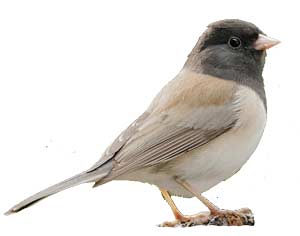 Fun Fact: Our “Oregon” subspecies is one of five subspecies in the United States. They were classified as four separate species the 1970s.
Fun Fact: Our “Oregon” subspecies is one of five subspecies in the United States. They were classified as four separate species the 1970s.
Song: A weak trill.
American Robin (Turdus migratorius)
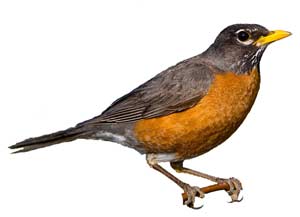 Fun Fact: Most robins spend the winter in the contiguous United States, but we see them less in the winter because they spend their time roosting in trees rather than searching for food on lawns like they do in the spring.
Fun Fact: Most robins spend the winter in the contiguous United States, but we see them less in the winter because they spend their time roosting in trees rather than searching for food on lawns like they do in the spring.
Song: Various calls, a high-pitched peek. Song involves repeated sets of flute-like notes.
There are many more species than these that can be seen in the San Bernardino mountains. Take a walk with binoculars and a field guide, and you’ll get to know these birds and more in no time! Happy birding!
Sources:
Peterson Field Guide to Birds of Western North America by Roger Tory Peterson
The Sibley Field Guide to Birds of Western North America by David Allen Sibley
www.allaboutbirds.org
www.xeno-canto.org
www.junglewalk.com
At High Trails Outdoor Science School, we literally force our instructors to write about elementary outdoor education, teaching outside, learning outside, our dirty classroom (the forest…gosh), environmental science, outdoor science, and all other tree hugging student and kid loving things that keep us engaged, passionate, driven, loving our job, digging our life, and spreading the word to anyone whose attention we can hold for long enough to actually make it through reading this entire sentence. Whew…. www.dirtyclassroom.com

Comments are closed.